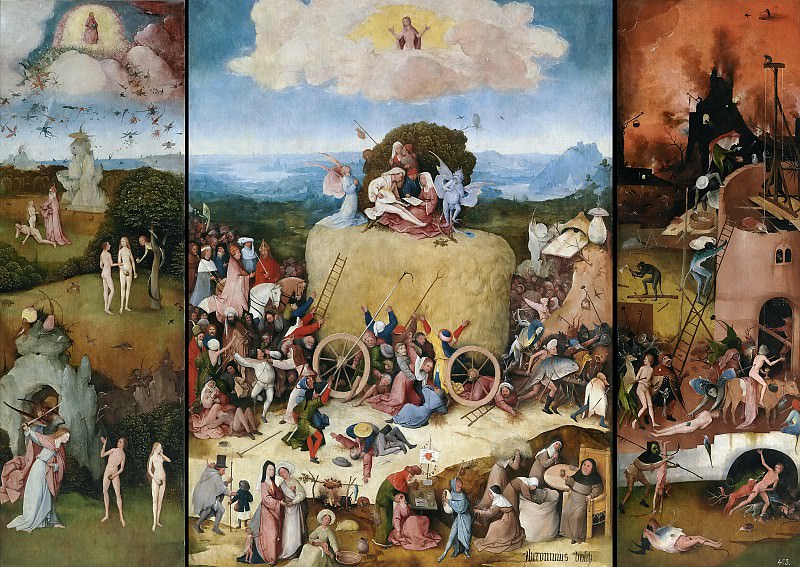El Bosco – El carro de heno Part 6 Prado Museum
Part 6 Prado Museum – El Bosco -- El carro de heno
Edit attribution
Download full size: 2830×2003 px (2,5 Mb)
Back to album: Part 6 Prado Museum
Hieronymus Bosch’s legacy is unique. The five-hundred-year-old triptych, "A Haystack," is unparalleled in world painting. Painted in the "alla prima" style without any preliminary sketches or drawings, the painting is aesthetically perfect, allegorical, and filled with philosophical depth. The painting consists of three canvases. The left one, "The Fall into Sin," shows in detail how man’s expulsion from Paradise occurred.
Description of Hieronymus Bosch’s painting "A Haystack
Hieronymus Bosch’s legacy is unique. The five-hundred-year-old triptych, "A Haystack," is unparalleled in world painting. Painted in the "alla prima" style without any preliminary sketches or drawings, the painting is aesthetically perfect, allegorical, and filled with philosophical depth.
The painting consists of three canvases. The left one, "The Fall into Sin," shows in detail how man’s expulsion from Paradise occurred. The central part, the largest in size, "The Haystack," vividly depicts the world of human vices and unnecessary vanity. The right side, "Hell," depicts what a life of sin will lead one to.
Each painting is its own world, where there is not a single superfluous detail. The landscapes, the attributes carry a deep meaning. In the beginning there was God, he gave life to all and drove the rebellious angels out of hell, turning them into underground demons. In the painting we see wacky images with wings, tails and various offshoots that leave the heavenly heights. But man did not become obedient either, succumbing to the serpent tempter with a human face. What this world led to is shown colorfully in the center section.
The haystack is a symbol of earthly riches, which all, though they may be possessed by theft, murder, or cunning, do not shrink from. All vices are drawn by the author at the foot of the haystack. People do not think that Christ is watching them, everyone is busy with their vices: nuns get drunk, common people fill their stomachs and indulge in carnal pleasures, only the wise old man shows his grandson a picture of the world, hoping that one can avoid temptation.
But the third part realistically shows where the werewolves with fish heads and human feet are dragging the hay wagon - to hell. There await blasphemers, debauchees, liars and thieves. The gallows, the rack, and the animals that devour people alive are ready for them.
Truly the world Bosch saw has changed little in five centuries. The painting is amazing, it makes you think and rethink familiar things.
Кому понравилось
Пожалуйста, подождите
На эту операцию может потребоваться несколько секунд.
Информация появится в новом окне,
если открытие новых окон не запрещено в настройках вашего браузера.
You need to login
Для работы с коллекциями – пожалуйста, войдите в аккаунт (open in new window).


















COMMENTS: 1 Ответы
Хорошая и умная работа Босха. Воз жизни, дьявольские существа тянут из Рая в Ад. Смиренные праведники, служители церкви и прочие овцы, бредут за возом (т. е. по жизни) пассивно. Народ же занят обычной и разнообразной жизнью. Что в целом весьма походит на истину. Умница Иероним.
Впоследствии Брейгель принял от Босха его образы Ада и существ Ада, но использовал их совсем для других идей.
You cannot comment Why?